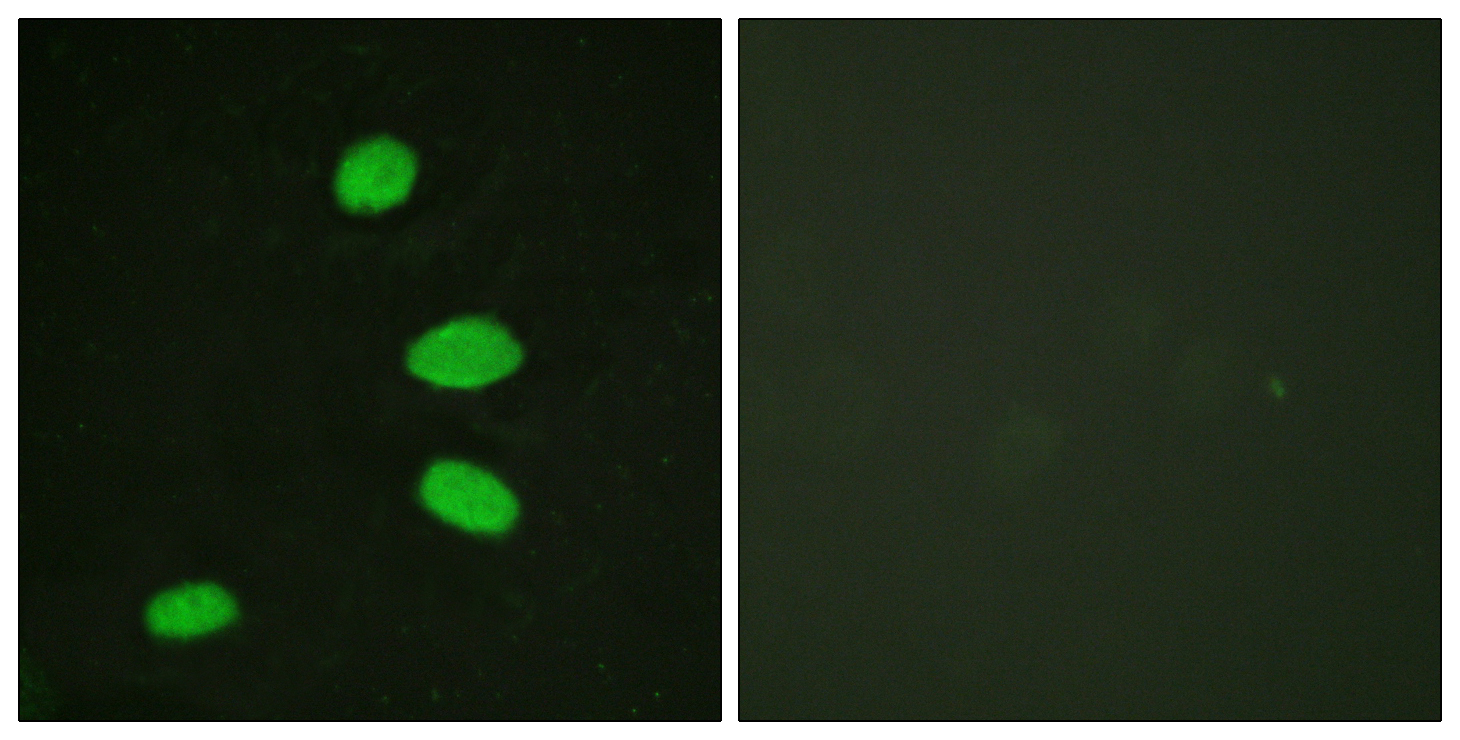p130 Polyclonal Antibody
- Catalog No.:YT3487
- Applications:IF;ELISA
- Reactivity:Human;Mouse;Rat
- Target:
- p130
- Fields:
- >>FoxO signaling pathway;>>Cell cycle;>>PI3K-Akt signaling pathway;>>Cellular senescence;>>Human papillomavirus infection;>>Viral carcinogenesis
- Gene Name:
- RBL2
- Protein Name:
- Retinoblastoma-like protein 2
- Human Gene Id:
- 5934
- Human Swiss Prot No:
- Q08999
- Mouse Gene Id:
- 19651
- Mouse Swiss Prot No:
- Q64700
- Rat Gene Id:
- 81758
- Rat Swiss Prot No:
- O55081
- Immunogen:
- The antiserum was produced against synthesized peptide derived from human RBL2. AA range:918-967
- Specificity:
- p130 Polyclonal Antibody detects endogenous levels of p130 protein.
- Formulation:
- Liquid in PBS containing 50% glycerol, 0.5% BSA and 0.02% sodium azide.
- Source:
- Polyclonal, Rabbit,IgG
- Dilution:
- IF 1:200 - 1:1000. ELISA: 1:5000. Not yet tested in other applications.
- Purification:
- The antibody was affinity-purified from rabbit antiserum by affinity-chromatography using epitope-specific immunogen.
- Concentration:
- 1 mg/ml
- Storage Stability:
- -15°C to -25°C/1 year(Do not lower than -25°C)
- Other Name:
- RBL2;RB2;Retinoblastoma-like protein 2;130 kDa retinoblastoma-associated protein;p130;Retinoblastoma-related protein 2;RBR-2;pRb2
- Molecular Weight(Da):
- 128kD
- Background:
- function:Key regulator of entry into cell division. Directly involved in heterochromatin formation by maintaining overall chromatin structure and, in particular, that of constitutive heterochromatin by stabilizing histone methylation. Recruits and targets histone methyltransferases SUV420H1 and SUV420H2, leading to epigenetic transcriptional repression. Controls histone H4 'Lys-20' trimethylation. Probably acts as a transcription repressor by recruiting chromatin-modifying enzymes to promoters. Potent inhibitor of E2F-mediated trans-activation, associates preferentially with E2F5. Binds to cyclins A and E. Binds to and may be involved in the transforming capacity of the adenovirus E1A protein. May act as a tumor suppressor.,miscellaneous:G0-restricted expression.,PTM:During G0 and early G1 phase of the cell cycle, phosphorylated on Ser-639 and on 5 sites within the domain B. Phosphorylation on Ser-672 in G1 leads to its ubiquitin-dependent proteolysis.,similarity:Belongs to the retinoblastoma protein (RB) family.,subunit:Interacts with AATF. Interacts with SUV420H1 and SUV420H2 (By similarity). Component of the DREAM complex (also named LINC complex) at least composed of E2F4, E2F5, LIN9, LIN37, LIN52, LIN54, MYBL1, MYBL2, RBL1, RBL2, RBBP4, TFDP1 and TFDP2. The complex exists in quiescent cells where it represses cell cycle-dependent genes. It dissociates in S phase when LIN9, LIN37, LIN52 and LIN54 form a subcomplex that binds to MYBL2. Interacts with RINT1.,
- Function:
- function:Key regulator of entry into cell division. Directly involved in heterochromatin formation by maintaining overall chromatin structure and, in particular, that of constitutive heterochromatin by stabilizing histone methylation. Recruits and targets histone methyltransferases SUV420H1 and SUV420H2, leading to epigenetic transcriptional repression. Controls histone H4 'Lys-20' trimethylation. Probably acts as a transcription repressor by recruiting chromatin-modifying enzymes to promoters. Potent inhibitor of E2F-mediated trans-activation, associates preferentially with E2F5. Binds to cyclins A and E. Binds to and may be involved in the transforming capacity of the adenovirus E1A protein. May act as a tumor suppressor.,miscellaneous:G0-restricted expression.,PTM:During G0 and early G1 phase of the cell cycle, phosphorylated on Ser-639 and on 5 sites within the domain B. Phosphorylat
- Subcellular Location:
- Nucleus.
- Expression:
- Human bone marrow,Placenta,Spleen,Testis,
- June 19-2018
- WESTERN IMMUNOBLOTTING PROTOCOL
- June 19-2018
- IMMUNOHISTOCHEMISTRY-PARAFFIN PROTOCOL
- June 19-2018
- IMMUNOFLUORESCENCE PROTOCOL
- September 08-2020
- FLOW-CYTOMEYRT-PROTOCOL
- May 20-2022
- Cell-Based ELISA│解您多样本WB检测之困扰
- July 13-2018
- CELL-BASED-ELISA-PROTOCOL-FOR-ACETYL-PROTEIN
- July 13-2018
- CELL-BASED-ELISA-PROTOCOL-FOR-PHOSPHO-PROTEIN
- July 13-2018
- Antibody-FAQs
- Products Images

- Immunofluorescence analysis of HeLa cells, using RBL2 Antibody. The picture on the right is blocked with the synthesized peptide.



